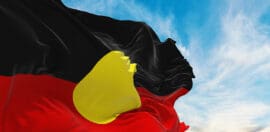Impact in Indigenous literature continues to grow

5 September 2022 at 4:48 pm
The Indigenous Literacy Foundation is marking a year of success in highlighting and supporting First Nations literature.
This Indigenous Literacy Day, the Indigenous Literacy Foundation (ILF) is counting its blessings.
The organisation, which works with First Nations communities to provide culturally relevant books and resources and publishes stories in-language, is marking its years of making an impact on the communities it services.
The ILF’s first Indigenous CEO Ben Bowen told Pro Bono News that Indigenous Literacy Day — to be celebrated on September 7 — is cause to celebrate the hard work conducted over previous years.
“Being able to tell stories in language and have literacy that’s multi-modal and multilingual… is just huge in our communities, and we just love the opportunity and the privilege that we’re being given to be able to celebrate it on the main stage and bring community to the forefront and showcase exactly all the hard work and success that they’re having,” he explained.
The day itself will be celebrated with a digital event in collaboration with Sydney Opera House. A second event will see community leaders June Oscar AO and Joe Ross do a live reading of Winthali (Fire), which aims to preserve the Bunuba language from Fitzroy Crossing in WA.
According to Bowen, there are only around 50 fluent speakers of the Bunuba language left.
Winthali, the first book in this language, will help a new generation of speakers come through, he said.
And it’s just the start: several more books in that language are already in the works.
“Ten, 20 years ago, it would have been really hard for us to find someone to write a book or be confident enough with language to put this stuff out there. Now we’re finding it’s a pipeline… there are so many projects, there are so many voices, there are so many champions in the space that these projects are coming thick and fast now,” Bowen said.
“That’s the major success we’re seeing. And that’s one community out of hundreds of communities that are doing this sort of work at the moment.”
A better way of measuring impact
The ILF has moved away from using terms like Closing the Gap and Naplan results to measure its impact, focusing instead on the strength and resilience of First Nations culture and knowledge.
Its 2021 impact report lists achievements like:
- Supporting 325 communities with 92,000 books
- Publishing 40 books in 11 languages
- Publishing the foundation’s first graphic novels.
Bowen said much of the ILF’s work has been around ensuring that First Nations communities have access to literature that means something to them, is culturally relevant and age appropriate, to help kids decode the images and text.
“If we get books that are written by mob for mob, then that context is there, the kids can actually see it,” he explained.
With so much non-verbal communication in the community, Bowen said illustrations play an important part in conveying context in Indigenous literature.
“When you’re in trouble with an aunty in our communities, they raise their eyebrows really high and how high it goes tells you how much trouble you’re in. So the fact that our kids can see a drawing of an aunty sitting there with an eyebrow [raised], they can start to decode that and then look at the text and start to understand that,” he said.
“We really want to pull back and focus on our kids’ skills and give them the opportunity to demonstrate their knowledge, to celebrate that knowledge, build that confidence up so that then they can be those self-driven learners that we know are successful.”
Bowen said there is now a community-wide interest in and acceptance of First Nations literature, embodied in the way that Indigenous literature is classified in bookshops.
Instead of having its own shelf, Indigenous authors are now seeing their books placed amongst the genres they write on: Indigenous science content is with other science books, for example.
“If you walked into a bookshop five years ago, you would have seen… the Indigenous Australian section and it would have been a shelf with all our books put in there,” Bowen said.
“Now, that section is almost gone and all of our books are being embedded across all those other shelves. Now, we’re seeing our writers across genres, across disciplines and supported by the institution to put those materials in the right places.
Planning for growth
There are big plans for the future of the ILF, which is looking to continue scaling up its work.
Bowen said the organisation would face a challenge in keeping up with its workload in communities.
The ILF is now looking into collaboration with like-minded partners to keep bringing First Nations literature to the fore and ensuring communities have access to it.
A priority is bringing the wider Australian community along for the ride “to support language, get more bilingual and in-language books out there, support more First Nation storytelling and publishing, and getting those books out there into the commercial space”, Bowen explained.
Key to this will be ensuring the intellectual property of writers is maintained, so that the cultural property is owned by the community and they don’t “lose language or stories”, he added.







